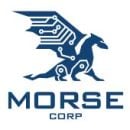Engineers at MORSE Corp don’t just drive innovation — they “out-innovate” themselves.
“MORSE is a research and engineering company first and foremost, so we need to innovate constantly to the point of out-innovating ourselves, or else our technology loses relevancy,” Nigel Mathes, chief technology officer of AI, told Built In.
The company’s engineers must stay one step ahead of industrywide changes, considering the solutions they create are designed to confront national security challenges. That’s why it’s critical for them to continuously share their ideas with each other, ensuring everyone stays informed and ready to drive progress.
Information is key to keeping up with technology’s transformation, which is something that WHOOP Senior AI Engineer Doug Schonholtz knows well. He and his peers at the wearable wellness device company do their part to stay up to date on the latest AI advancements.
“This space moves incredibly fast, so everyone on the team is constantly reading what models are being released, how costs are changing and how we can pull in user data more effectively to better answer members’ questions,” he shared.
While fostering innovation is key to business success, it also keeps technologists engaged and connected to each other. Head of Product Petya Tombout has seen this firsthand at Simply Business, where she guides teams’ efforts to better serve the needs of small businesses by gathering solid data around customer behavior, which has led to an increase in out-of-the-box thinking and a greater sense of cohesion.
“We’ve found that the pursuit of data-driven solutions is not just about building better products — it’s about building a better team,” Tombout said.
Below, Mathes, Schonholtz and Tombout share more about how they and their teammates embrace innovation, the impact this has on the work they deliver and the role it plays in bolstering team culture.
WHOOP’s wearable device allows individuals to track health and fitness metrics, such as daily performance scores, real-time stress levels, menstrual cycles and physical strain.
What practices does your team employ to foster innovation, and how have these practices led to more creative, out-of-the-box thinking?
I am on the AI support team and was previously on the AI coach team that empowered users to chat with all of their data with AI. This space moves incredibly fast, so everyone on the team is constantly reading what models are being released, how costs are changing and how we can pull in user data more effectively to better answer members’ questions. We have a repository explicitly for doing experiments with AI that has been incredibly useful.
In this repository, we constantly run small tests against our existing code and new experiments we want to try and measure the results to be metric-driven. This results in trying new retrieval patterns, new models and new strategies for projects. It also often means making things that are extremely simple with large language models and then rapidly iterating as often as we can to ship big features very quickly without having to define a lot of logic to support them, as the LLMs can work through the edge cases on their own.
“This space moves incredibly fast, so everyone on the team is constantly reading what models are being released, how costs are changing and how we can pull in user data more effectively to better answer members’ questions.”
How has a focus on innovation increased the quality of your team’s work?
We are currently working on classifying languages and automatically responding to support cases in the correct language. By focusing on innovation, we already have the infrastructure to test a variety of different approaches very quickly. We then watch metrics move and adjust accordingly. Language classification is surprisingly tricky to do well, and LLMs will only get it right about 90 percent of the time, which would result in a terrible member experience. By pulling in a different library, deploying it and then iterating, our team was able to make this 99.9 percent accurate. This was only possible due to our constant focus on building metrics, looking for better tooling and being data-driven.
Some other examples include pulling in external benchmarks when determining the best AI models to use in our code assistance tools, AI support or coaching system, as well as building our own benchmarks and using Anthropic’s model context protocol to accelerate our development team or our products.
How has a focus on innovation bolstered your team’s culture?
By focusing on innovation, we are constantly all learning, experimenting and lifting each other up. We all are learning new tools, and when we see metrics go up, we celebrate together. We make sure we teach each other what works and quietly let go of the things that do not. Building at the bleeding edge is a lot of fun, and we are building the infrastructure to enable that.

MORSE Corp develops solutions to tackle challenges faced by the U.S. National Security Ecosystem.
What practices does your team employ to foster innovation, and how have these practices led to more creative, out-of-the-box thinking?
MORSE is a research and engineering company first and foremost, so we need to innovate constantly to the point of out-innovating ourselves, or else our technology loses relevancy. This focus brings in talented people with good ideas and passion to continuously think about solving challenging problems in unconventional ways. We encourage everyone to have ideas and bring those ideas to bear to solve problems. We encourage exploration of those ideas and often turn these into internal directives to explore new paths. We have teams we call “Pathfinders” that take identified problems, experiment with new approaches and turn around results that can ultimately help the warfighter.
“We have teams we call ‘Pathfinders’ that take identified problems, experiment with new approaches and turn around results that can ultimately help the warfighter.”
I host a weekly AI chat that anyone in the company is welcome to attend. This is a freeform, open virtual forum to discuss topics in AI, machine learning and machine learning operations. You can come with topics you are interested in or want to learn more about, ideas you may have for specific projects here at MORSE that you want to brainstorm more, or problems you’re encountering while implementing things in projects you’re currently working on.
How has a focus on innovation increased the quality of your team’s work?
We have many examples of topics that spin out of our AI chat into Pathfinders’ efforts. We take modern AI research in literature, academia, open source and the commercial industry and look at how to apply it properly to the problems our customers have. We aren’t here to solve easy problems; the problems we work on are unsolved until we solve them.
MORSE keeps pace with the cutting edge of generative AI research, and this has led to program success. We develop testing methodologies that benchmark the newest LLM and vision language model releases on data relevant for national security. We develop internal tools to increase MORSE effectiveness and encourage everyone at the company to develop tools and come up with ideas that use modern AI to accelerate technology development and keep us on the cutting edge of innovation.
Simply Business’ digital marketplace connects small businesses with insurance coverage solutions.
What practices does your team employ to foster innovation, and how have these practices led to more creative, out-of-the-box thinking?
In the dynamic realm of digital product innovation, particularly within the insurance sector, understanding the customer journey is paramount. At Simply Business, our customer lifecycle team has transcended data collection, transforming it into the foundation of our strategic advocacy for small businesses. We’re not just insuring small businesses; we’re building a dynamic, tech-driven ecosystem that fuels their growth.
Our approach to discovery and innovation is grounded in a continuous stream of data deep dives with our analytical partners. Each reporting and analytics request is a targeted exploration, designed to extract actionable intelligence on customer pain points and behavioral patterns, allowing us to provide digital-first self-service support where and when our customers need it. The product team has weekly data review sessions, allowing us to rapidly iterate to enhance customer experience or lay the groundwork for innovative projects. We bring that data to collaborative sessions with product, analytics, customer experience and engineering to define our vision. By grounding our tech efforts in solid data around customer behavior, we’ve seen a boost in creative, out-of-the-box thinking.
“By grounding our tech efforts in solid data around customer behavior, we’ve seen a boost in creative, out-of-the-box thinking.”
How has a focus on innovation increased the quality of your team’s work?
At Simply Business, we’ve learned that reliable innovation lies in de-risking assumptions through iterative prototyping rather than immediately pursuing complex, resource-intensive implementations. This approach allows us to validate the efficacy of potential solutions with minimal investment, ensuring we’re solving real problems and seeking validation from our customers along the way.
Instead of launching fully-fledged, feature-rich products, we prioritize “demand testing” through prototypes. This might involve A/B testing, “fake door” experiments to gauge interest or even manually-supported solutions that lay the groundwork for future AI automation. This strategy allows us to gather concrete user feedback and data, enabling us to refine our solutions before scaling them. Our focus on innovation has fostered a culture of continuous improvement, where we prioritize data-driven experimentation and customer-centric solutions. This has resulted in higher-quality work, increased efficiency and a more impactful customer experience.
How has a focus on innovation bolstered your team’s culture?
Before immersing myself in this data-driven product management approach, I wouldn’t have believed that data could be a powerful catalyst for team cohesion and enrichment. Yet our team’s relentless pursuit of innovation, fueled by high-velocity data analysis and collaborative opportunity mapping, has proven me wrong.
These sessions have established a predictable cadence of thought-provoking discussions that consistently yield unexpected insights. It’s become a dynamic, almost gamified process, where each team member is a detective, piecing together data clues to unlock the “next level” of customer understanding and solution development. The thrill of uncovering hidden patterns and identifying impactful opportunities has created a shared sense of purpose and excitement.
In essence, our focus on innovation has transformed our team into a highly collaborative, intellectually engaged and genuinely connected group. We’ve found that the pursuit of data-driven solutions is not just about building better products — it’s about building a better team.











